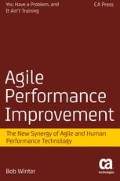Abstract
At the conclusion of each sprint, Scrum calls for the team to hold a retrospective meeting. It is the lynchpin of continuous improvement and responsiveness to change. By scheduling this event regularly, every one, two, or four weeks, depending on iteration length, the team finds focus on improving performance, much more often than in non-Agile practices, where reflection usually occurs only at the conclusion of a big project or at some other long interval.
At regular intervals, the team reflects on how to become more effective, then tunes and adjusts its behavior accordingly.
—Principles Behind the Agile Manifesto
Access this chapter
Tax calculation will be finalised at checkout
Purchases are for personal use only
Notes
- 1.
Robert C. Martin, Agile Software Development: Principles, Patterns, and Practices (Upper Saddle River, NJ: Prentice Hall, 2003), p. 22.
- 2.
In Scrum, an impediment is an issue that is blocking a story from getting done. Typically, the scrum master fields the impediments from the team during the daily standup and then works to resolve them.
- 3.
Major League Baseball’s Mario Mendoza was a weak-hitting infielder after whom the dividing line between competent and incompetent batter is named. To be “below the Mendoza line” is to have a batting average below .200. Mendoza himself batted .215 for his career, which spanned from 1974 to 1982.
- 4.
Work in process refers to the number of stories to which a person or team is committed at a time. A WIP limit puts a cap on the number of stories.
- 5.
- 6.
Recall the Agile Manifesto has come to value working software over comprehensive documentation.
- 7.
See, for example, Frederick F. Reichheld, The One Number You Need to Grow, Harvard Business Review, December 2003; available at https://hbr.org/2003/12/the-one-number-you-need-to-grow (retrieved March 20, 2015).
- 8.
Stephen Orsini, “Bieker’s Cavitation Fix,” Sailing World, October 21, 2013; available at http://www.sailingworld.com/racing/biekers-cavitation-fix (accessed January 12, 2015).
Author information
Authors and Affiliations
Rights and permissions
Copyright information
© 2015 CA
About this chapter
Cite this chapter
Winter, B. (2015). Continuous Improvement Lore. In: Agile Performance Improvement. Apress, Berkeley, CA. https://doi.org/10.1007/978-1-4842-0892-2_8
Download citation
DOI: https://doi.org/10.1007/978-1-4842-0892-2_8
Publisher Name: Apress, Berkeley, CA
Print ISBN: 978-1-4842-0893-9
Online ISBN: 978-1-4842-0892-2
eBook Packages: Professional and Applied ComputingProfessional and Applied Computing (R0)Apress Access Books

